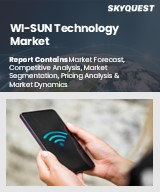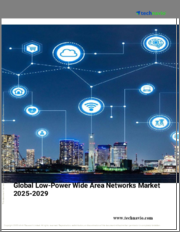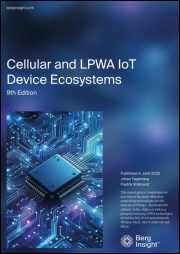
|
시장보고서
상품코드
1819758
WI-SUN 기술 시장 규모, 점유율, 성장 분석 : 용도별, 연결 유형별, 최종 용도별, 주파수 대역별, 지역별 - 산업 예측(2025-2032년)WI-SUN Technology Market Size, Share, and Growth Analysis, By Application (Smart Metering, Smart Lighting), By Connectivity Type (Point-to-Point, Point-to-Multipoint), By End Use, By Frequency Band, By Region - Industry Forecast 2025-2032 |
||||||
세계 WI-SUN 기술 시장 규모는 2023년에 33억 달러로 평가되었으며, 2024년 35억 9,000만 달러에서 2032년에는 70억 5,000만 달러로 성장하여 예측 기간(2025-2032년) 동안 CAGR 8.8%로 증가할 전망입니다.
사물인터넷(IoT) 애플리케이션과 스마트 시티 구상을 지원하는 신뢰할 수 있는 통신 솔루션에 대한 수요 증가는 WI-SUN 기술의 유망한 미래를 시사하고 있습니다. 유틸리티 장비 및 스마트 미터 관리에서 무선 통신의 필요성이 증가함에 따라 무선 통신의 채택이 더욱 촉진될 것입니다. 유리한 정부 규제와 스마트 인프라에 대한 투자가 시장 성장을 촉진하고 있습니다. 기업들은 연결성을 우선시하기 때문에 장치 간 원활한 데이터 전송을 위해 최첨단 기술을 활용하고 있습니다. 도시화가 빠르게 진행되는 개발도상국에는 미개척의 큰 비즈니스 기회가 있습니다. 도시 지역의 급격한 증가로 인해 교통, 의료, 농업 등의 분야에서 지속가능한 상호연결 솔루션에 대한 수요가 증가하고 있습니다. 효율성을 높이고 WI-SUN 기술의 도입을 촉진하는 맞춤형 애플리케이션을 만들기 위해서는 지자체, 교육기관, 산업계의 협력이 필수적입니다.
목차
소개
- 조사 목적
- 조사 범위
- 정의
조사 방법
- 정보 조달
- 2차와 1차 데이터 방법
- 시장 규모 예측
- 시장 가정과 제한
주요 요약
- 세계 시장 전망
- 공급과 수요 동향 분석
- 부문별 기회 분석
시장 역학과 전망
- 시장 개요
- 시장 규모
- 시장 역학
- 성장 촉진요인과 기회
- 성장 억제요인과 과제
- Porters 분석
주요 시장 인사이트
- 핵심성공요인
- 경쟁 정도
- 주요 투자 기회
- 시장 생태계
- 시장 매력 지수(2024년)
- PESTEL 분석
- 거시경제 지표
- 밸류체인 분석
- 가격 분석
- 기술 평가
- 규제 상황
WI-SUN 기술 시장 규모 : 용도별 & CAGR(2025-2032년)
- 시장 개요
- 요트 전세
- 스마트 조명
- 스마트 그리드
- 홈 오토메이션과 빌딩 자동화
WI-SUN 기술 시장 규모 : 연결 유형별 & CAGR(2025-2032년)
- 시장 개요
- 포인트 투 포인트
- 포인트 투 멀티포인트
- 메시
WI-SUN 기술 시장 규모 : 최종 용도별 & CAGR(2025-2032년)
- 시장 개요
- 유틸리티
- 산업
- 주거용
WI-SUN 기술 시장 규모 : 주파수 대역별 & CAGR(2025-2032년)
- 시장 개요
- 서브 GHz
- 2.4 GHz대
WI-SUN 기술 시장 규모 & CAGR(2025-2032년)
- 북미
- 미국
- 캐나다
- 유럽
- 독일
- 스페인
- 프랑스
- 영국
- 이탈리아
- 기타 유럽
- 아시아태평양
- 중국
- 인도
- 일본
- 한국
- 기타 아시아태평양
- 라틴아메리카
- 브라질
- 기타 라틴아메리카
- 중동 및 아프리카
- GCC 국가
- 남아프리카공화국
- 기타 중동 및 아프리카
경쟁 정보
- 상위 5개사의 비교
- 주요 기업의 시장 포지셔닝(2024년)
- 주요 시장 기업이 채용한 전략
- 최근의 시장 동향
- 기업의 시장 점유율 분석(2024년)
- 주요 기업 개요
- 기업 상세
- 제품 포트폴리오 분석
- 기업 부문별 점유율 분석
- 매출 전년비 비교(2022-2024년)
주요 기업 개요
- Itron(USA)
- Cisco Systems(USA)
- Landis+Gyr(Switzerland)
- Silicon Labs(USA)
- Texas Instruments(USA)
- Renesas Electronics Corporation(Japan)
- Analog Devices(USA)
- Murata Manufacturing Co., Ltd.(Japan)
- Toshiba Corporation(Japan)
- NXP Semiconductors(Netherlands)
- Microchip Technology(USA)
- Digi International(USA)
- Semtech(USA)
- EnOcean(Germany)
- Exegin Technologies(Canada)
- Trilliant(USA)
- Broadcom(USA)
- Rohm Semiconductor(Japan)
- Sierra Wireless(Canada)
- Brilliant Holdings(Japan)
결론과 제안
KSM 25.09.29Global WI-SUN Technology Market size was valued at USD 3.3 billion in 2023 and is poised to grow from USD 3.59 billion in 2024 to USD 7.05 billion by 2032, growing at a CAGR of 8.8% during the forecast period (2025-2032).
The growing demand for reliable communication solutions to support Internet of Things (IoT) applications and smart city initiatives signals a promising future for Wi-SUN technology. The increasing necessity for wireless communication in managing utility devices and smart metering will further boost its adoption. Favorable government regulations and investments in smart infrastructure are enhancing market growth. As organizations prioritize connectivity, they are harnessing cutting-edge technologies for seamless data transfer across devices. Developing nations, with their rapid urbanization, present significant untapped opportunities. The surge in urban areas has heightened the demand for sustainable, interconnected solutions across sectors such as transportation, healthcare, and agriculture. Collaborative efforts among municipal bodies, educational institutions, and industries are crucial for creating tailored applications that promote efficiency and stimulate adoption of Wi-SUN technology.
Top-down and bottom-up approaches were used to estimate and validate the size of the Global WI-SUN Technology market and to estimate the size of various other dependent submarkets. The research methodology used to estimate the market size includes the following details: The key players in the market were identified through secondary research, and their market shares in the respective regions were determined through primary and secondary research. This entire procedure includes the study of the annual and financial reports of the top market players and extensive interviews for key insights from industry leaders such as CEOs, VPs, directors, and marketing executives. All percentage shares split, and breakdowns were determined using secondary sources and verified through Primary sources. All possible parameters that affect the markets covered in this research study have been accounted for, viewed in extensive detail, verified through primary research, and analyzed to get the final quantitative and qualitative data.
Global WI-SUN Technology Market Segments Analysis
Global WI-SUN Technology Market is segmented by Application, Connectivity Type, End Use, Frequency Band and region. Based on Application, the market is segmented into Smart Metering, Smart Lighting, Smart Grid and Home and Building Automation. Based on Connectivity Type, the market is segmented into Point-to-Point, Point-to-Multipoint and Mesh. Based on End Use, the market is segmented into Utilities, Industrial and Residential. Based on Frequency Band, the market is segmented into Sub-GHz and 2.4 GHz. Based on region, the market is segmented into North America, Europe, Asia Pacific, Latin America and Middle East & Africa.
Driver of the Global WI-SUN Technology Market
The global WI-SUN technology market is being significantly influenced by the acceleration of multi-vendor interoperability and streamlined procurement processes facilitated by formal standardization initiatives. The introduction of specialized certification programs has mitigated risks associated with the deployment of extensive networks for smart metering and city assets, particularly in regions like India. The endorsement of standardized RF protocols, such as Wi-SUN FAN (IEEE 2857) for smart meters, has positioned Wi-SUN as a favorable choice over proprietary solutions. This alignment of policy and certification not only enhances market preferences but also leads to shorter request-for-proposal (RFP) cycles, fostering greater efficiency in the market.
Restraints in the Global WI-SUN Technology Market
The Global WI-SUN Technology market faces certain constraints that hinder its expansion. A major challenge is the necessity for large outdoor networks to incorporate devices from various manufacturers to avoid vendor lock-in. Despite Wi-SUN's commitment to transparency, companies often emphasize the importance of FAN certification and the use of testbeds to establish Service Level Agreements (SLAs) concerning latency, recovery, and scalability before committing to widespread implementation. Additionally, the presence of mixed technology stacks and outdated equipment can significantly impede the deployment process, creating further obstacles in the adoption of WI-SUN solutions in diverse settings.
Market Trends of the Global WI-SUN Technology Market
The Global WI-SUN Technology market is experiencing significant growth as it strategically aligns with the burgeoning fields of 5G networks and edge computing. This integration is particularly prominent in smart city initiatives and industrial IoT applications, where localized data processing enhances real-time analytics capabilities for smart meters and edge sensors. The synergy between Wi-SUN technology and advanced telecommunications frameworks is improving latency and responsiveness, making it increasingly viable for mission-critical use cases. As organizations transition towards hybrid designs that leverage both Wi-SUN and other networking technologies, the market is poised for expansive development and innovation within the connected ecosystem.
Table of Contents
Introduction
- Objectives of the Study
- Scope of the Report
- Definitions
Research Methodology
- Information Procurement
- Secondary & Primary Data Methods
- Market Size Estimation
- Market Assumptions & Limitations
Executive Summary
- Global Market Outlook
- Supply & Demand Trend Analysis
- Segmental Opportunity Analysis
Market Dynamics & Outlook
- Market Overview
- Market Size
- Market Dynamics
- Drivers & Opportunities
- Restraints & Challenges
- Porters Analysis
- Competitive rivalry
- Threat of substitute
- Bargaining power of buyers
- Threat of new entrants
- Bargaining power of suppliers
Key Market Insights
- Key Success Factors
- Degree of Competition
- Top Investment Pockets
- Market Ecosystem
- Market Attractiveness Index, 2024
- PESTEL Analysis
- Macro-Economic Indicators
- Value Chain Analysis
- Pricing Analysis
- Technology Assessment
- Regulatory Landscape
Global WI-SUN Technology Market Size by Application & CAGR (2025-2032)
- Market Overview
- Smart Metering
- Smart Lighting
- Smart Grid
- Home and Building Automation
Global WI-SUN Technology Market Size by Connectivity Type & CAGR (2025-2032)
- Market Overview
- Point-to-Point
- Point-to-Multipoint
- Mesh
Global WI-SUN Technology Market Size by End Use & CAGR (2025-2032)
- Market Overview
- Utilities
- Industrial
- Residential
Global WI-SUN Technology Market Size by Frequency Band & CAGR (2025-2032)
- Market Overview
- Sub-GHz
- 2.4 GHz
Global WI-SUN Technology Market Size & CAGR (2025-2032)
- North America (Application, Connectivity Type, End Use, Frequency Band)
- US
- Canada
- Europe (Application, Connectivity Type, End Use, Frequency Band)
- Germany
- Spain
- France
- UK
- Italy
- Rest of Europe
- Asia Pacific (Application, Connectivity Type, End Use, Frequency Band)
- China
- India
- Japan
- South Korea
- Rest of Asia-Pacific
- Latin America (Application, Connectivity Type, End Use, Frequency Band)
- Brazil
- Rest of Latin America
- Middle East & Africa (Application, Connectivity Type, End Use, Frequency Band)
- GCC Countries
- South Africa
- Rest of Middle East & Africa
Competitive Intelligence
- Top 5 Player Comparison
- Market Positioning of Key Players, 2024
- Strategies Adopted by Key Market Players
- Recent Developments in the Market
- Company Market Share Analysis, 2024
- Company Profiles of All Key Players
- Company Details
- Product Portfolio Analysis
- Company's Segmental Share Analysis
- Revenue Y-O-Y Comparison (2022-2024)
Key Company Profiles
- Itron (USA)
- Company Overview
- Business Segment Overview
- Financial Updates
- Key Developments
- Cisco Systems (USA)
- Company Overview
- Business Segment Overview
- Financial Updates
- Key Developments
- Landis+Gyr (Switzerland)
- Company Overview
- Business Segment Overview
- Financial Updates
- Key Developments
- Silicon Labs (USA)
- Company Overview
- Business Segment Overview
- Financial Updates
- Key Developments
- Texas Instruments (USA)
- Company Overview
- Business Segment Overview
- Financial Updates
- Key Developments
- Renesas Electronics Corporation (Japan)
- Company Overview
- Business Segment Overview
- Financial Updates
- Key Developments
- Analog Devices (USA)
- Company Overview
- Business Segment Overview
- Financial Updates
- Key Developments
- Murata Manufacturing Co., Ltd. (Japan)
- Company Overview
- Business Segment Overview
- Financial Updates
- Key Developments
- Toshiba Corporation (Japan)
- Company Overview
- Business Segment Overview
- Financial Updates
- Key Developments
- NXP Semiconductors (Netherlands)
- Company Overview
- Business Segment Overview
- Financial Updates
- Key Developments
- Microchip Technology (USA)
- Company Overview
- Business Segment Overview
- Financial Updates
- Key Developments
- Digi International (USA)
- Company Overview
- Business Segment Overview
- Financial Updates
- Key Developments
- Semtech (USA)
- Company Overview
- Business Segment Overview
- Financial Updates
- Key Developments
- EnOcean (Germany)
- Company Overview
- Business Segment Overview
- Financial Updates
- Key Developments
- Exegin Technologies (Canada)
- Company Overview
- Business Segment Overview
- Financial Updates
- Key Developments
- Trilliant (USA)
- Company Overview
- Business Segment Overview
- Financial Updates
- Key Developments
- Broadcom (USA)
- Company Overview
- Business Segment Overview
- Financial Updates
- Key Developments
- Rohm Semiconductor (Japan)
- Company Overview
- Business Segment Overview
- Financial Updates
- Key Developments
- Sierra Wireless (Canada)
- Company Overview
- Business Segment Overview
- Financial Updates
- Key Developments
- Brilliant Holdings (Japan)
- Company Overview
- Business Segment Overview
- Financial Updates
- Key Developments



















